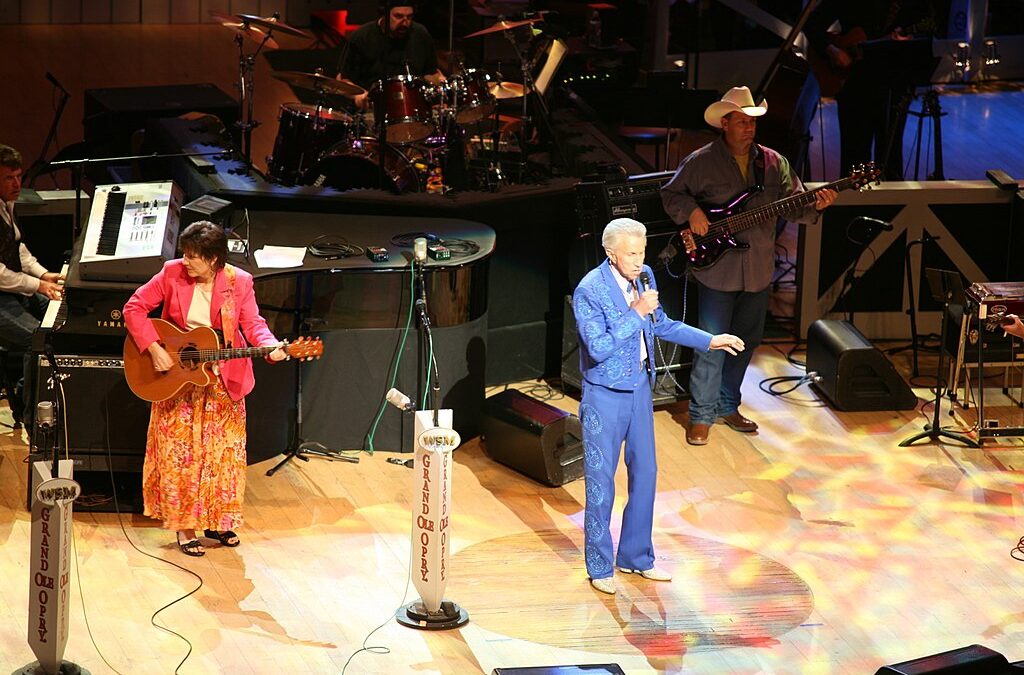As the strains of country music have reverberated through the decades, so too has its influence on popular fashion. Rooted in the rural landscapes of the American South and West, country music has spawned a unique aesthetic that captures the hearts of fans and fashionistas alike.
From the humble beginnings of cowboy boots and Stetson hats to the glitz and glamour of rhinestone-studded jackets, the fashion inspired by country music icons is a testament to the genre’s enduring allure.
The 1940s: The Singing Cowboy
In the 1940s, the image of the singing cowboy took center stage, with stars like Roy Rogers and Gene Autry wearing classic Western attire on screen and in live performances. The cowboy look—complete with boots, jeans and a button-down shirt—became synonymous with country music, inspiring generations of performers and fans alike.
The 1950s: Nudie Suits and Rhinestone Cowboys
In the 1950s, the cowboy aesthetic was elevated to new heights thanks to the pioneering work of designer Nudie Cohn. Nicknamed “the Rodeo Tailor,” Cohn was responsible for creating the iconic “Nudie Suits,” which were adorned with intricate embroidery, rhinestones and appliqués. These extravagant ensembles were worn by country music legends like Hank Williams, Porter Wagoner and Elvis Presley.
The Nudie Suit became a symbol of the glitzy and glamorous side of country music and the look was immortalized in the 1975 song “Rhinestone Cowboy” by Glen Campbell. As a result, country musicians and fans alike began to embrace flashier, more elaborate outfits in the decades that followed.
The 1960s and ’70s: Country Hippie and Denim Revolution
As the counterculture movement of the 1960s and ’70s swept the nation, country music was not immune to its influence. Country musicians like Gram Parsons and Emmylou Harris began to adopt a “country hippie” aesthetic, which combined elements of bohemian and Western styles.
Denim became a staple of country fashion during this time, as artists like Johnny Cash, Dolly Parton and Waylon Jennings embraced the fabric in all its forms—from bell-bottoms and jean jackets to denim vests and skirts. The popularity of denim in country music helped to cement its status as a versatile and enduring fashion staple.
The 1980s: Urban Cowboy and Western Chic
The 1980 film “Urban Cowboy,” starring John Travolta, sparked a resurgence of interest in cowboy culture and Western fashion. The movie’s stylish blend of urban and country aesthetics led to a craze for Western-themed clothing, accessories and even home décor.
High fashion brands took note of the trend and began to incorporate Western elements into their designs, as seen in Ralph Lauren’s iconic “Santa Fe” collection, which debuted in 1981. Celebrities like Madonna and Michael Jackson were also seen donning cowboy hats and fringed jackets, proving that country music’s influence had firmly crossed over into mainstream popular culture.
The 1990s and 2000s: Neo-Traditionalism and the Rise of Vintage Country
The 1990s saw a return to a more traditional country aesthetic, with artists like George Strait, Alan Jackson and Reba McEntire embracing cowboy hats, boots and classic Western shirts. This “neo-traditional” movement was a direct response to the urban cowboy craze.
The Current Aesthetic: Individualism and Eclecticism in Country Music Fashion
Today’s country music fashion aesthetic can be characterized by its embrace of individualism and eclecticism, reflecting the diverse range of artists and styles within the genre. This contemporary approach to country fashion incorporates a variety of influences, from the traditional Western wear of its roots to modern streetwear and high-fashion trends.
Traditional Western Wear: Many country artists continue to draw inspiration from the genre’s heritage, donning cowboy hats, boots, denimand classic button-down shirts. This nod to tradition can be seen in the styles of artists like Jon Pardi, Miranda Lambertand Midland.
Modern Streetwear and High-Fashion: As country music has evolved and expanded its reach, so too has its fashion sense. Younger, more genre-blending artists like Lil Nas X, Kacey Musgraves and Maren Morris have incorporated elements of streetwear and high-fashion into their looks, showcasing a more urban, contemporary side of country.
Vintage and Retro-Inspired: Many country musicians are also embracing vintage and retro-inspired styles, drawing from various decades and subgenres. Artists like Chris Stapleton, Brandi Carlileand Jason Isbell often wear clothing reminiscent of the ’60s and ’70s, combining elements of country hippie, denim and classic Western wear.
Feminine and Glamorous: Female country artists, in particular, have championed a more glamorous and feminine aesthetic. Performers like Carrie Underwood, Kelsea Balleriniand Mickey Guyton often opt for sparkly gowns, sequinsand bold prints on the red carpet and stage, demonstrating the lasting influence of the rhinestone cowboy era.
Custom and Statement Pieces: In keeping with the individualism that characterizes modern country fashion, many artists collaborate with designers to create custom and statement pieces that showcase their unique personalities. For example, Dolly Parton’s signature style often features bright colors, fringeand rhinestones, while Eric Church is known for his signature aviator sunglasses and leather jackets.
The current fashion aesthetic in country music is diverse and multifaceted, reflecting the genre’s rich history and ongoing evolution. From traditional Western wear to modern street wear and high-fashion trends, today’s country artists demonstrate a wide range of influences and styles, embodying the spirit of individualism and eclecticism that defines contemporary country music.
story by Claudia Johnson

